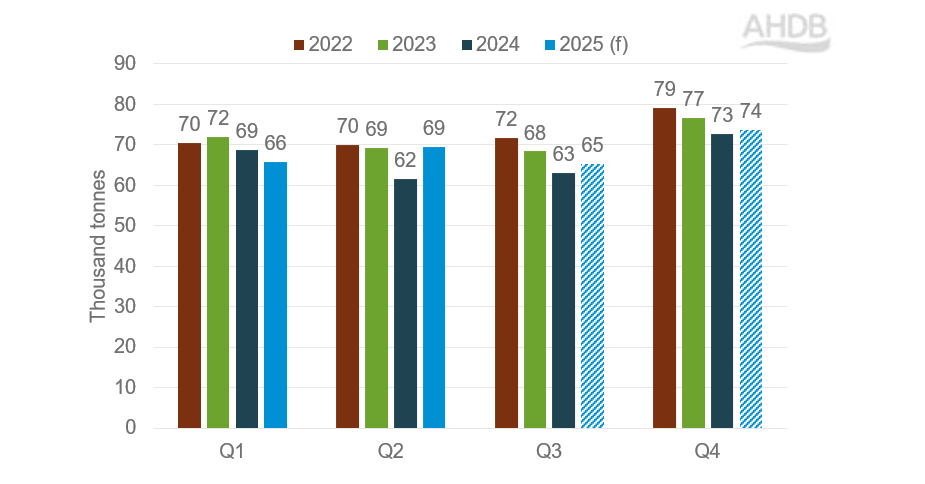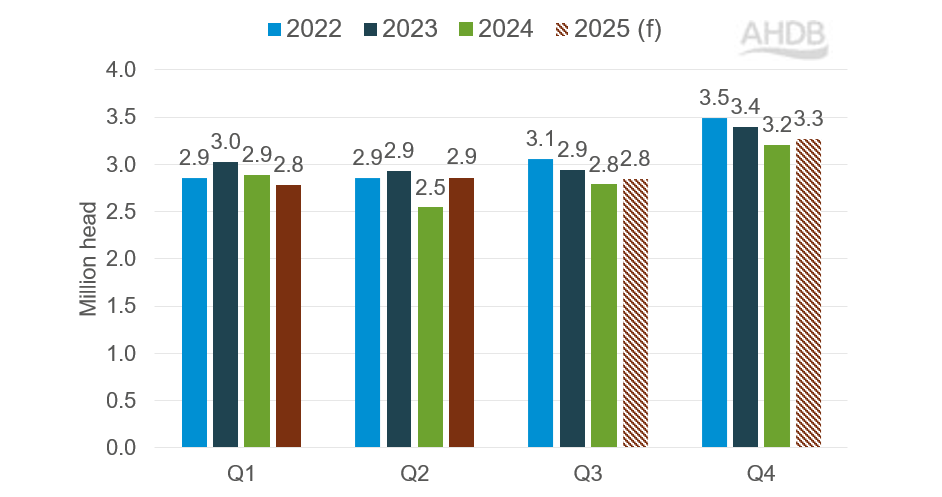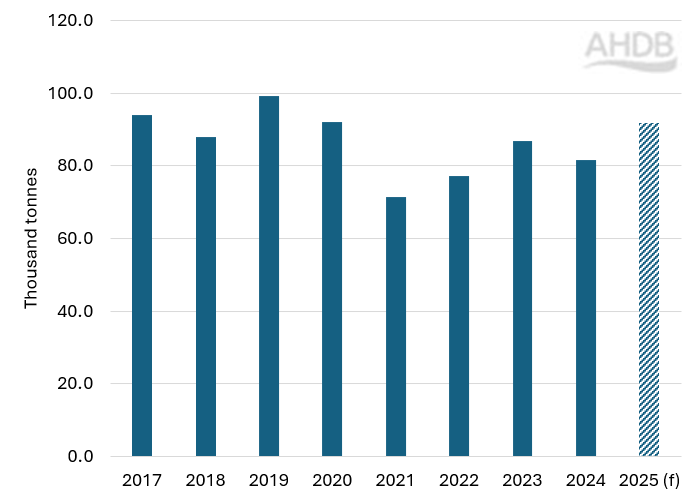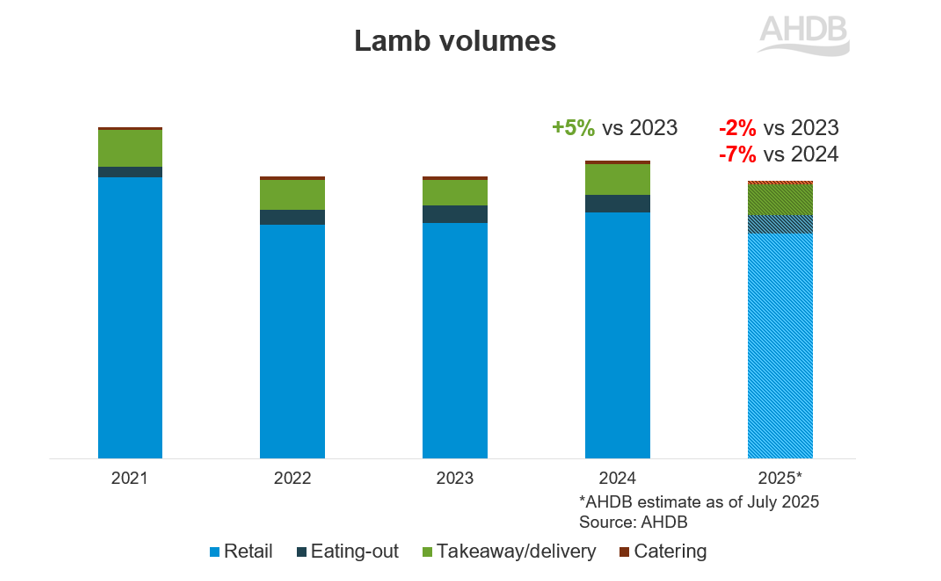- Home
- Lamb market outlook
Lamb market outlook
Key points
- 2025 total sheep meat production has been revised down to 274,000 tonnes (+2.9% year-on-year) from 276,000 tonnes
- 2025 clean sheep slaughter is now forecast at 11.7 million head (+3% vs 2024)
- Forecasts for both UK sheep meat imports and exports have risen from our previous outlook, to 79,000 tonnes (-5% year-on-year) and 92,000 tonnes (+13% year-on-year), respectively
- Forecast consumption of lamb volumes in 2025 have been revised downwards to a 7% decline compared to last year’s levels
Production
In this mid-year update of the 2025 UK lamb outlook, total sheep meat production has been revised down from previous forecasts to 274 thousand tonnes. This fall has been driven by a reduced estimated lamb slaughter, now forecast at 11.7 million head for the year. Lamb slaughter has been revised down following a slow start to 2025 before the bulk of last year’s old season lamb (OSL) carry-over came forward in the spring. However, this carry-over has not been as large as initially predicted, suggesting that lamb losses experienced in 2024 were far higher than previously anticipated.
Actual and forecast UK sheep meat production

Source: Defra, LAA, AHDB forecasts in hashed bars
Heavier clean sheep carcases from this seasonally higher proportion of OSLs have supported production levels in the first half (H1) of 2025. We now anticipate these weights to fall in line with seasonal averages as new season lambs (NSL) come to make up the entirety of lamb supply.
Indeed, NSLs have been slow to market this year – likely influenced by later lambing and poor grass conditions across some areas of the UK. As such, the seasonality of the anticipated H2 lamb kill has been adjusted to reflect these trends.
Actual and forecast UK clean sheep slaughter

Source: Defra, LAA, AHDB forecasts in hashed bars
Focusing in on adult sheep (ewes and rams), following a slight uptick in Q2, the 2025 adult sheep slaughter forecast is largely unchanged from previous estimates at 1.38 million head (-4.3% year-on-year).
Looking further ahead, carry-over of this season’s lambs into 2026 is anticipated to be lower than that seen this year, as a result of more favourable lambing and growing conditions throughout the spring. However, this will be entirely dependent on conditions throughout the rest of summer and autumn.
Trade
Imports
The market has seen bumper lamb imports so far in 2025, with volumes up 10% on the year from January to May. This aligns with our seasonally lower domestic production at the very start of the year and improved access for southern hemisphere product under Free Trade Agreements with both New Zealand and Australia.
As a result of this, UK imports for the full year of 2025 have been revised upwards to 79,000 tonnes (carcase weight equivalent). However, this volume remains 5% below 2024 levels due to higher anticipated domestic production throughout the rest of 2025 as the current lamb crop comes to market.
Exports
Export volumes so far in 2025 have also risen greatly on the year, running 13% above 2024 levels for the January to May period.
This could be in part due to a reduced consumption of British lamb domestically combined with increased production, allowing for more product to be available for export.
Moreover, following an incredibly wide price differential for much of 2024, the UK lamb price has now dropped below the continental European equivalent, potentially making UK product more attractive to European importers.
These factors, combined with the anticipated fall in domestic consumption (as detailed below), have resulted in the forecast for UK sheep meat exports to rise to 92 thousand tonnes (carcase weight equivalent), up 10% on the year.
UK sheep meat exports

Source: HMRC via TDM LLC
Demand
In 2024, total lamb volumes increased by 5% year-on-year, making it the fastest growing red meat. For 2025 we expected a level of economic uncertainty as detailed in our economic outlook, and this has impacted lamb more than previously predicted. So far in 2025, lamb volumes in retail have been down 10% (Kantar, 24 w/e 15 June 2025) and the out-of-home (OOH) market flat. For 2025 as a whole, we predict this trend will continue. Therefore, predictions have changed since the January outlook and declines have accelerated.
Therefore, we forecast lamb volumes will be down 7% in 2025.
For more details on 2025 trends and cut specifics, see our retail and foodservice dashboards.

Lamb volumes by channel

*AHDB estimate as of July 2025
Source: AHDB
In retail, the importance of promotions for lamb during 2024 was very apparent, particularly around key events. With farmgate prices increasing over 2024, we predicted retailers would be unable to maintain such deep promotions, especially around Easter, Ramadan and Eid, but this was not the case, with promotional levels actually increasing in the first six months of the year. However, this did not translate into growth, and despite more lamb roasting volumes being sold on promotion at Easter 2025, volumes declined (Kantar, 2 w/e 20 April 2025). It appears that the higher price point for lamb overall is causing some shoppers to be priced out of the category, and despite AHDB predictions that lamb volumes would remain buoyant versus 2023, it has been unable to achieve this.
For out-of-home we predicted at the beginning of the year volumes to be flat year-on-year, which has been the case so far this year. Lamb in dining out has seen growth (benefiting from some operators adding more premium mains to menus (Lumina)), while takeaways have declined, as less consumers utilise this channel. We predict value-led lamb meals, such as kebabs and curries, will continue to perform well, driving our OOH predictions into slight growth for the last half of the year.
The lamb outlook might be improved if the industry:
- Provides inspiration for tasty, easy-to-cook lamb dishes in a way that gives reassurance to consumers who may be less familiar with how to cook lamb
- Utilises tactical support, particularly around key events, such as promotions, meal deals and prominent placing in-store
- Encourage consumers with the right messaging in-store, online, on pack and in foodservice
- Boost lamb presence on menus to capture premium out-of-home dining occasions
- Addresses health concerns by communicating the health benefits of lamb, such as being a good source of B12, iron and protein.
- In the longer term, look to maintain and build consumer trust, demonstrating where farming values (animal welfare, environmental stewardship and expertise) are shared with consumers. See our consumer reputation landscape hub for more information
AHDB has a range of marketing activities planned for the year, including the new Let’s Eat Balanced campaign. Please visit our marketing pages for more information. For more insight around consumer demand, visit our retail and consumer page.
Sign up to receive the latest analysis and forecasts from AHDB
While AHDB seeks to ensure that the information contained on this webpage is accurate at the time of publication, no warranty is given in respect of the information and data provided. You are responsible for how you use the information. To the maximum extent permitted by law, AHDB accepts no liability for loss, damage or injury howsoever caused or suffered (including that caused by negligence) directly or indirectly in relation to the information or data provided in this publication.
All intellectual property rights in the information and data on this webpage belong to or are licensed by AHDB. You are authorised to use such information for your internal business purposes only and you must not provide this information to any other third parties, including further publication of the information, or for commercial gain in any way whatsoever without the prior written permission of AHDB for each third party disclosure, publication or commercial arrangement. For more information, please see our Terms of Use and Privacy Notice or contact the Director of Corporate Affairs at info@ahdb.org.uk © Agriculture and Horticulture Development Board. All rights reserved.

